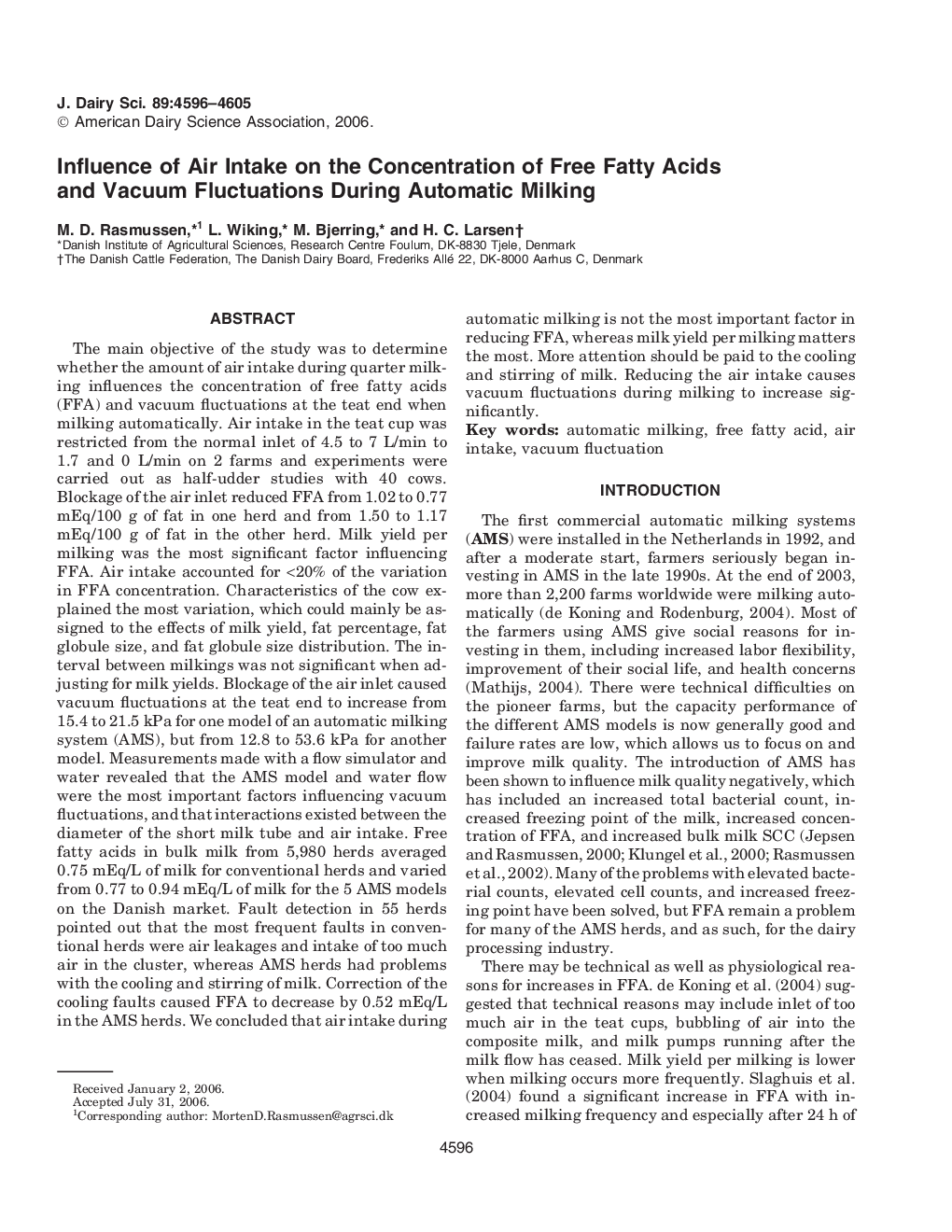| کد مقاله | کد نشریه | سال انتشار | مقاله انگلیسی | نسخه تمام متن |
|---|---|---|---|---|
| 2440840 | 1108127 | 2006 | 10 صفحه PDF | دانلود رایگان |
عنوان انگلیسی مقاله ISI
Influence of Air Intake on the Concentration of Free Fatty Acids and Vacuum Fluctuations During Automatic Milking
دانلود مقاله + سفارش ترجمه
دانلود مقاله ISI انگلیسی
رایگان برای ایرانیان
موضوعات مرتبط
علوم زیستی و بیوفناوری
علوم کشاورزی و بیولوژیک
علوم دامی و جانورشناسی
پیش نمایش صفحه اول مقاله

چکیده انگلیسی
The main objective of the study was to determine whether the amount of air intake during quarter milking influences the concentration of free fatty acids (FFA) and vacuum fluctuations at the teat end when milking automatically. Air intake in the teat cup was restricted from the normal inlet of 4.5 to 7 L/min to 1.7 and 0 L/min on 2 farms and experiments were carried out as half-udder studies with 40 cows. Blockage of the air inlet reduced FFA from 1.02 to 0.77 mEq/100Â g of fat in one herd and from 1.50 to 1.17 mEq/100Â g of fat in the other herd. Milk yield per milking was the most significant factor influencing FFA. Air intake accounted for <20% of the variation in FFA concentration. Characteristics of the cow explained the most variation, which could mainly be assigned to the effects of milk yield, fat percentage, fat globule size, and fat globule size distribution. The interval between milkings was not significant when adjusting for milk yields. Blockage of the air inlet caused vacuum fluctuations at the teat end to increase from 15.4 to 21.5 kPa for one model of an automatic milking system (AMS), but from 12.8 to 53.6 kPa for another model. Measurements made with a flow simulator and water revealed that the AMS model and water flow were the most important factors influencing vacuum fluctuations, and that interactions existed between the diameter of the short milk tube and air intake. Free fatty acids in bulk milk from 5,980 herds averaged 0.75 mEq/L of milk for conventional herds and varied from 0.77 to 0.94 mEq/L of milk for the 5 AMS models on the Danish market. Fault detection in 55 herds pointed out that the most frequent faults in conventional herds were air leakages and intake of too much air in the cluster, whereas AMS herds had problems with the cooling and stirring of milk. Correction of the cooling faults caused FFA to decrease by 0.52 mEq/L in the AMS herds. We concluded that air intake during automatic milking is not the most important factor in reducing FFA, whereas milk yield per milking matters the most. More attention should be paid to the cooling and stirring of milk. Reducing the air intake causes vacuum fluctuations during milking to increase significantly.
ناشر
Database: Elsevier - ScienceDirect (ساینس دایرکت)
Journal: Journal of Dairy Science - Volume 89, Issue 12, December 2006, Pages 4596-4605
Journal: Journal of Dairy Science - Volume 89, Issue 12, December 2006, Pages 4596-4605
نویسندگان
M.D. Rasmussen, L. Wiking, M. Bjerring, H.C. Larsen,